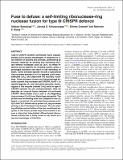Files in this item
Fuse to defuse : a self-limiting ribonuclease-ring nuclease fusion for type III CRISPR defence
Item metadata
| dc.contributor.author | Samolygo, Aleksei | |
| dc.contributor.author | Athukoralage, Januka Sahan | |
| dc.contributor.author | Graham, Shirley | |
| dc.contributor.author | White, Malcolm | |
| dc.date.accessioned | 2020-05-05T15:30:01Z | |
| dc.date.available | 2020-05-05T15:30:01Z | |
| dc.date.issued | 2020-06-19 | |
| dc.identifier | 267472995 | |
| dc.identifier | ba7f000a-ce21-4f35-bd98-cde5cf0281b7 | |
| dc.identifier | 85086524603 | |
| dc.identifier | 85086524603 | |
| dc.identifier | 32347937 | |
| dc.identifier | 000574284500031 | |
| dc.identifier.citation | Samolygo , A , Athukoralage , J S , Graham , S & White , M 2020 , ' Fuse to defuse : a self-limiting ribonuclease-ring nuclease fusion for type III CRISPR defence ' , Nucleic Acids Research , vol. 48 , no. 11 , pp. 6149–6156 . https://doi.org/10.1093/nar/gkaa298 | en |
| dc.identifier.issn | 0305-1048 | |
| dc.identifier.other | ORCID: /0000-0003-1543-9342/work/73700680 | |
| dc.identifier.other | ORCID: /0000-0002-1666-0180/work/73701845 | |
| dc.identifier.uri | https://hdl.handle.net/10023/19884 | |
| dc.description | Funding: Biotechnology and Biological Sciences Research Council [REF BB/S000313/1 to M.F.W.]; Funding for open access charge: RCUK block grant. | en |
| dc.description.abstract | Type III CRISPR systems synthesise cyclic oligoadenylate (cOA) second messengers in response to viral infection of bacteria and archaea, potentiating an immune response by binding and activating ancillary effector nucleases such as Csx1. As these effectors are not specific for invading nucleic acids, a prolonged activation can result in cell dormancy or death. Some archaeal species encode a specialised ring nuclease enzyme (Crn1) to degrade cyclic tetra-adenylate (cA4) and deactivate the ancillary nucleases. Some archaeal viruses and bacteriophage encode a potent ring nuclease anti-CRISPR, AcrIII-1, to rapidly degrade cA4 and neutralise immunity. Homologues of this enzyme (named Crn2) exist in type III CRISPR systems but are uncharacterised. Here we describe an unusual fusion between cA4-activated CRISPR ribonuclease (Csx1) and a cA4-degrading ring nuclease (Crn2) from Marinitoga piezophila. The protein has two binding sites that compete for the cA4 ligand, a canonical cA4-activated ribonuclease activity in the Csx1 domain and a potent cA4 ring nuclease activity in the C-terminal Crn2 domain. The cA4 binding affinities and activities of the two constituent enzymes in the fusion protein may have evolved to ensure a robust but time-limited cOA-activated ribonuclease activity that is finely tuned to cA4 levels as a second messenger of infection. | |
| dc.format.extent | 8 | |
| dc.format.extent | 3451995 | |
| dc.language.iso | eng | |
| dc.relation.ispartof | Nucleic Acids Research | en |
| dc.subject | QH301 Biology | en |
| dc.subject | Genetics | en |
| dc.subject | NDAS | en |
| dc.subject.lcc | QH301 | en |
| dc.title | Fuse to defuse : a self-limiting ribonuclease-ring nuclease fusion for type III CRISPR defence | en |
| dc.type | Journal article | en |
| dc.contributor.sponsor | BBSRC | en |
| dc.contributor.institution | University of St Andrews. Biomedical Sciences Research Complex | en |
| dc.contributor.institution | University of St Andrews. School of Biology | en |
| dc.identifier.doi | 10.1093/nar/gkaa298 | |
| dc.description.status | Peer reviewed | en |
| dc.identifier.grantnumber | BB/S000313/1 | en |
This item appears in the following Collection(s)
Items in the St Andrews Research Repository are protected by copyright, with all rights reserved, unless otherwise indicated.

